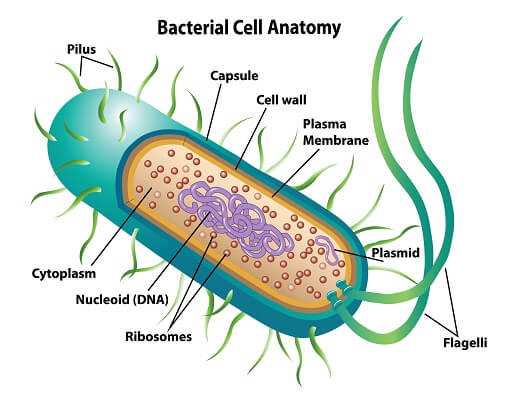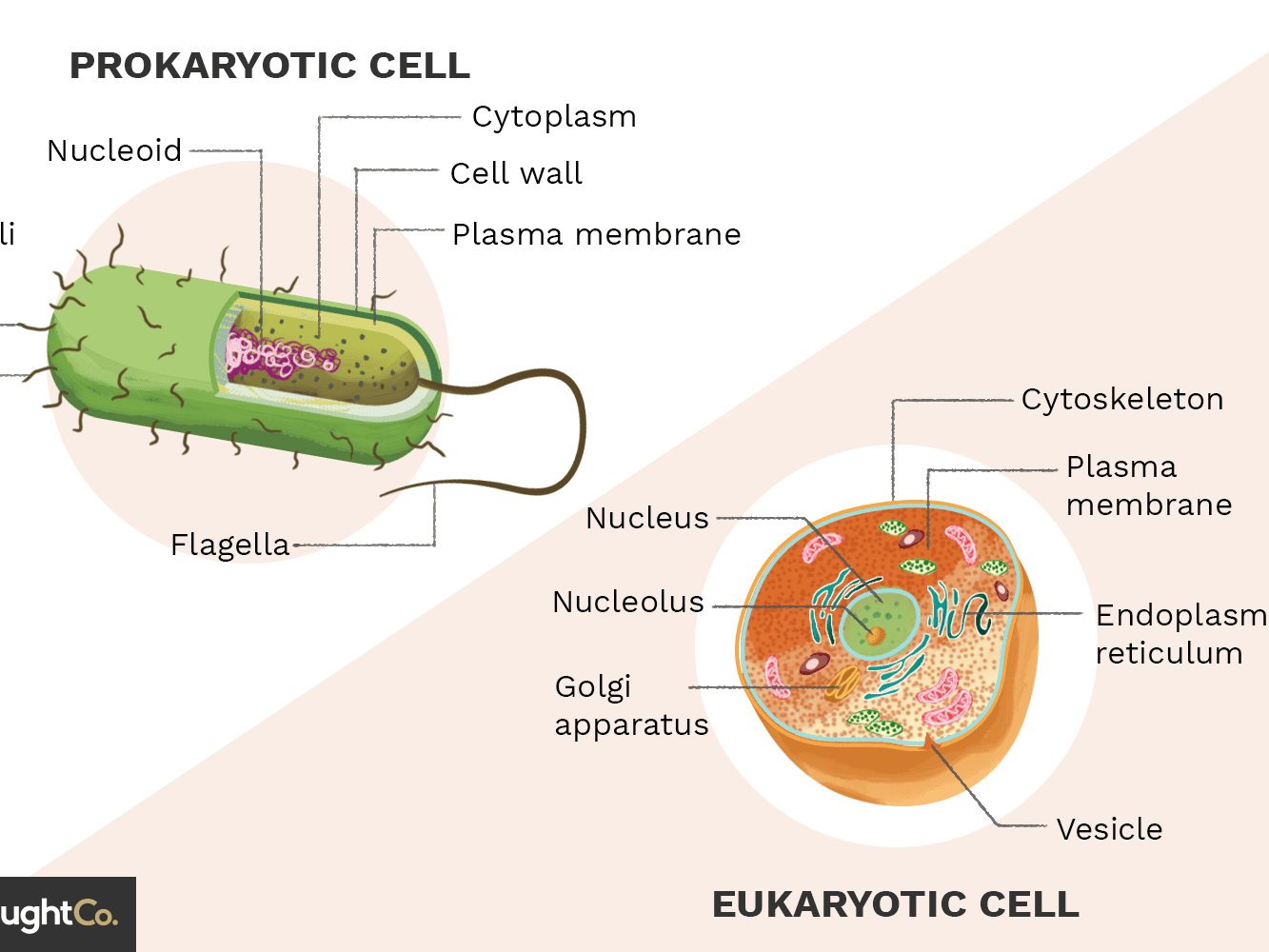Chapters
In this article, we will discuss the key structural features of a prokaryotic cell and compare the structure of the eukaryotic cell and prokaryotic cell. So, let us get started.

Structure of a Prokaryotic Cell
Plant and animal cells are examples of eukaryotic cells, whereas bacterial cell is an example of prokaryotic cells. The size of the prokaryotic cell is quite smaller than that of a eukaryotic cell. It is estimated that a prokaryotic cell is about 100 to 1000 times smaller than the eukaryotic cell. As opposed to a eukaryotic cell, a prokaryotic cell has the following features:
- The cytoplasm in a prokaryotic cell does not have membrane-bound organelles
- The ribosomes of the prokaryotic cell are structurally smaller (70 S) as compared to those present in eukaryotic cells (80 S)
- A prokaryotic cell does not contain any nucleus. Instead of a nucleus, a prokaryotic cell has a single circular DNA molecule that is present freely in the cytoplasm and has no connection with proteins
- A prokaryotic cell contains a cell wall that has murein. Murein is a glycoprotein.
Besides the above structural features, some other structures are also present in many prokaryotic cells. These structures help to differentiate the species from others, besides acting as a selective advantage. The selective advantage refers to the characteristic of an organism that helps it in survival and better reproduction than other organisms in a population in a specific environment. Examples of these features include:
i) Capsules
An outer layer referred to as a capsule surrounds some prokaryotes, for instance, bacteria. Sometimes this layer is also referred to as a slime capsule. This layer serves a dual purpose in the bacteria:
- It prevents drying out of bacteria
- It protects the bacteria from attack by immune system cells of the host organism
Plasmids
Plasmids refer to the tiny loops of DNA that are distinct from the primary circular DNA molecule. Plasmids have genes that are transferred between prokaryotes. Examples of such genes include genes for antibiotic resistance. Plasmids are not present in all prokaryotes.
Flagellum
Flagella (singular: Flagellum) refer to the long, tail-like structure that rotates so that the prokaryote can move. More than one flagellum is present in some prokaryotes.
A prokaryotic bacterial cell is shown in the diagram below:

Before comparing the structures of a typical prokaryotic and eukaryotic cell, first, let us recall the structures that are present in a eukaryotic cell along with the functions they perform.
Structure of a Eukaryotic Cell
The following structures are present in a typical eukaryotic cell:
- Cell surface membrane: Also known as the plasma membrane. It surrounds every cell and controls the exchange of materials in and out of the cell.
- Cell wall: A freely permeable membrane that is present outside the cell surface membrane. In plant cells, the cell wall is composed of cellulose and provides structural support to the cell membrane.
- Nucleus: The nucleus is present in all eukaryotic cells and has the genetic material of the cell referred to as chromatin.
- Mitochondria: Mitochondria (singular: Mitochondrion) is a site of aerobic respiration in the eukaryotic cells. As the name implies, aerobic respiration is a type of respiration that requires oxygen.
- Chloroplasts: Chloroplasts are found in green parts of the plant and contain a green pigment called chlorophyll. Chloroplasts are a primary site for photosynthesis in plants.
- Ribosomes: Formed in the nucleolus, ribosomes are the site for protein synthesis.
- Endoplasmic Reticulum: It includes rough endoplasmic reticulum (RER) and smooth endoplasmic reticulum (SER). RER is a surface covered in ribosomes, whereas SER does not have ribosomes on the surface. The main purpose of the RER is to process proteins produced by the ribosomes, whereas SER plays a vital role in the production, processing, and storage of lipids, carbohydrates, and steroids.
- Golgi Apparatus: They are flattened sacs of the membrane that seem like SER (Smooth Endoplasmic Reticulum). The primary purpose of the Golgi Apparatus is modifying and packaging proteins into vesicles or lysosomes.
- Large Permanent Vacuole: Plant cells contain permanent large vacuoles, whereas animal cells have small temporary vacuoles.
- Vesicle: It refers to a membrane-bound sac that plays a prominent role in transportation and storage.
- Lysosome: Specialized forms of vesicles that contain hydrolytic enzymes.
- Centrioles: Hollow fibres of microtubules that are not present in flowering plants and fungi
- Microtubules: They make up the cell’s cytoskeleton which has a diameter of about 25 nm.
- Microvilli: Projections of the cell membrane that increase the surface area for better absorption.
- Cilia: Hair-like projections composed of microtubules that allow the movement of substances over the cell’s surface.
- Flagella (Singular: Flagellum): Their structure resembles that of cilia and they contract to assist the movement of the cell.
We have discussed the typical structures present in a eukaryotic cell in detail. Now, let us see what the differences between a typical prokaryotic and eukaryotic cell are.

Prokaryotic Vs Eukaryotic Cell
In this section of the article, we will compare the features of a typical prokaryotic and eukaryotic cell.
1. Size
The diameter of a prokaryotic cell is about 0.5 to 5 micrometres, whereas the diameter of a eukaryotic cell is up to 40 micrometres. This shows that a eukaryotic cell is many times larger than a prokaryotic cell.
2. Genome
A prokaryotic cell has circular DNA having no proteins in the cytoplasm. On the other hand, DNA in a eukaryotic cell is associated with proteins known as histones that are created into chromosomes.
3. Cell division
Cell division in a prokaryotic cell occurs by binary fission and no spindle is involved. By contrast, cell division in eukaryotes occurs by meiosis or mitosis and includes a spindle to separate chromosomes.
4. Ribosomes
In prokaryotes, 70S ribosomes are present, whereas in eukaryotes 80S ribosomes are present.
5. Organelles
In prokaryotic cells, some organelles are present which are not bounded by a membrane. On the other hand, several membrane-bound organelles are found in a eukaryotic cell. Examples of organelles include the Golgi complex, vacuoles, lysosomes, mitochondria, nucleus, and chloroplasts. Some no membrane-bound organelles present in the eukaryotic cell include centrioles, microtubules, and ribosomes.
6. Cell wall
The cell wall in a prokaryotic cell is composed of peptidoglycan (a complex of polysaccharides and amino acids) and murein. Cell wall in different eukaryotic cells is made up of different materials. For instance, the cell wall in plants is made up of lignin or cellulose, whereas the cell wall in fungi is made up of chitin which resembles cellulose but contains nitrogen.













Keep on teaching us,you are excellent teachers
This is great
Thanks a lot for this book,it really helped me a lot
It’s useful to me
Thanks a lot for your Better book!
It’s a perfect article, go ahead